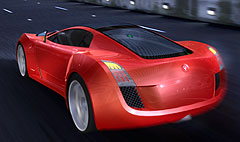Make / Model Search
News - General News - TechnologyVirtual Car an Aussie RealitySci-fi: The Virtual Reality (VR) concept car project provides a platform for Australian automotive manufacturers and suppliers to showcase their wares. The Melbourne motor show plays host to the first 3-D virtual reality concept car8 Mar 2005 AN AUSTRALIAN world-first, with massive commercial application potential, has made its public debut at this week’s Melbourne International Motor Show. Dubbed the Virtual Reality (VR) concept car project, it is a commercial-standard, fully animated, three-dimensional model of a vehicle. Local manufacturers Ford, Holden and Toyota contributed CAD computer-aided design inputs to the project, and the show vehicle is an amalgamation from all three. With the computer-generated ability to move inside, around and even through any given object, it provides a multi-faceted platform for Australian automotive manufacturers and suppliers to showcase their wares. Other benefits include huge reductions in the cost of building models and prototypes, the ease of portability, the ability to observe conference-style from anywhere in the world and the capability for quick changes if necessary. As an example, the VR concept car’s costs are in the vicinity of $500,000, while the 1990s “aXcess Australia” concept cars, which successfully promoted the Australian automotive industry globally, exceeded $13 million. Already, there is believed to be plenty of interest worldwide for the Virtual Room, well beyond its obvious automotive applications. Throughout this year and into 2006, the concept car will travel to the United States – for the Society of Automotive Engineers’ 100th Anniversary conference in Detroit, for example – as well as Japan, Thailand, India, China and Germany. It will also make an Aussie re-appearance at this October’s Australian International Motor Show in Sydney and next year’s Commonwealth Games in Melbourne. Unique in the world, the VR concept car employs new levels of virtual reality, using 360-degree stereoscopic projection, to create an illusion that solid objects and moving images are contained within a ‘Virtual Room’ – hence the VROOM tagline. In a nutshell, observers see things as if they’re “in the round”, according to Paul Staubli, Managing Partner of Applied Creative, one of the co-developers of the VR concept car. “The Virtual Room is a room within a room,” he explains. “The outer one controls the light levels inside, while the inner room consists of eight rear projection screens, onto which the digital models are projected from within, in stereo, creating a 3D environment.” Wearing 3D glasses, the audience can walk around the perimeter of the inner room, observing the VR concept car. The Virtual Room was co-developed in Melbourne by a consortium of Victorian universities, chiefly the Royal Melbourne Institute of Technology (RMIT), Swinburne and Monash, along with the Victorian Government and the Melbourne Museum.  A pioneer in the art, RMIT’s first accessible VR centre came into operation in July 1999. Swinburne developed the underlying technology, the Melbourne Museum houses it and RMIT personnel are responsible for content development. A pioneer in the art, RMIT’s first accessible VR centre came into operation in July 1999. Swinburne developed the underlying technology, the Melbourne Museum houses it and RMIT personnel are responsible for content development.The VR concept car project represents collaboration between the Victorian Office of Manufacturing (Automotive Industries), Applied Creative, the Victorian Automobile Chamber of Commerce, VROOM inc and Edag Australia (and overseas), with support from FAPM, Austrade and the Federal Department of Foreign Affairs and Trade. Proving the potential for time as well as cost-cutting, the idea for the VR concept crystallised only last July, and with the Victorian Government moving quickly for its part, approval was granted by December last year. Mr Staubli and his team are convinced both the concept car application as well as the Virtual Room have an almost limitless growth capability both here and worldwide, and well beyond the automotive arena. “This application goes right to the heart of automotive development,” he said. OBSERVER IMPRESSIONSAN extraordinary level of talent and hard work has helped make the Virtual Room and its contents a ‘seeing is believing’ experience.Wearing the 3-D glasses and walking around the outside of the Inner Room, I was confronted with outstandingly life-like objects, aided by very real levels of visual and aural stimuli. Oddly enough it’s like you’re in a bubble moving around – or inside – what ever is ahead of you. In the case of a vehicle it means zooming in on schematics, going through cutaways, peering inside components and seeing, and hearing and feeling (via vibrating devices nearby) the movement of parts, such as a warbling engine. It is clear that that the VROOM concept has worldwide applications throughout the automotive industry, and well beyond. So perhaps the most amazing thing about it is that nobody has thought of doing this before. During GoAuto’s tour a number of automotive inventions highlighting Australian ingenuity were mentioned – such as front-wheel drive in the early part of last century, and the famous coupe-utility from 1934. If the automotive world embraces this outstanding technology with similar enthusiasm, then Australians should – like the 3D images of the VROOM concept – be beside themselves. |
Click to shareGeneral News articlesResearch General News Motor industry news |









Facebook Twitter Instagram